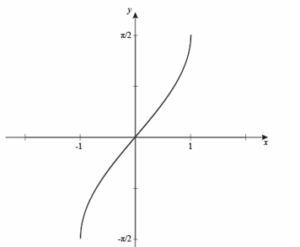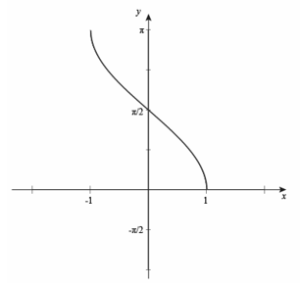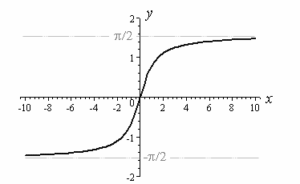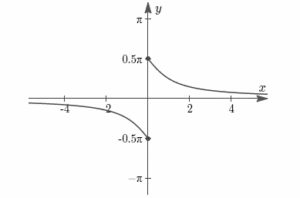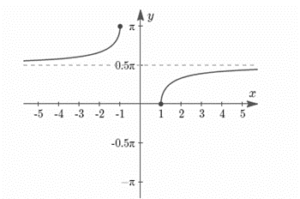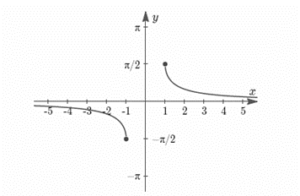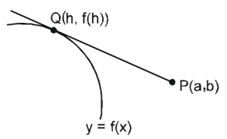Inverse Trigonometric Functions formulaThe formula for inverse trigonometric functions are as stated below | |
| Description | Formula |
| Arcsine Function | Arcsine function is an inverse of sine function which is denoted by sin-1 The formula for arcsin is given as sin-1(-x)=-sin-1(x), x∈[-1, 1] Domain of arcsin is -1≤x≤1 Range of arcsin is -π/2≤y≤π/2 Differentiation of sin-1x is 1/√(1-x^2 ) |
| Arccosine Function | Arccosine function is an inverse of cosine function which is denoted by cos-1 cos-1(-x)=π-cos-1(x), x∈[-1, 1] Domain of arccos is -1≤x≤1 Range of arccos is 0≤y≤π Differentiation of cos-1x is –1/√(1-x^2 ) |
| Arctangent Function | Arctangent function is an inverse of tangent function which is denoted by tan-1 tan-1(-x)=-tan-1(x), x∈R Domain of Arctangent is -∞≤x≤∞ Range of Arctangent is -π/2≤y≤π/2 Differentiation of tan-1x is 1/(1+x^2 ) |
| Arc cotangent (Arc cot) Function | Arc cotangent function is an inverse of cotangent function which is denoted by cot-1 cot-1(-x)=π-cot-1(x), x∈R Domain of Arc cotangent is -∞≤x≤∞ Range of Arc cotangent is 0≤y≤π Differentiation of cot-1x is –1/(1+x^2 ) |
| Arc secant Function | Arc secant function is an inverse of cosine function which is denoted by cot-1 sec-1(-x)=π-sec-1(x), |x|≥ 1 Domain of Arc secant is -∞≤x≤-1 or 1-∞≤x≤-∞ Range of Arc secant is 0≤y≤π, y ≠π/2 Differentiation of sec-1x is (-1)/(|x| √(x^2-1)) |
| Arc cosecant Function | Arc cosecant function is an inverse of sine function which is denoted by cosec-1 cosec-1(-x)=-cosec-1(x), x≥ 1 Domain of Arc cosecant is -∞≤x≤-1 or 1-∞≤x≤-∞ Range of Arc cosecant is -π/2≤y≤π/2, y ≠0 Differentiation of cosec-1(x) is (-1)/(|x| √(x^2-1)) |
Straight Line FormulaThe formula for straight line are as stated below | |
| Description | Formulas |
| Distance Formula | d=√((x_1-x_2 )^2-(y_1-y_2 )^2 ) |
| Section Formula | x=(mx_2±nx_1)/(m±n);y=(my_2±ny_1)/(m±n) |
| Centroid, Incentre and Excenter | Centroid G((x_1+x_2+x_3)/3 ,(y_1+y_2+y_3)/3) In center I(ax_1+bx_2+cx_3)/(a+b+c),(ay_1+by_2+cy_3)/(a+b+c) Excentre I1(-a_x+bx_2+cx_3)/(-a+b+c),(-ay_1+by_2+cy_3)/(-a+b+c) |
| Area of Triangle | ∆ ABC=1/2 |x_1 y_1 1 x_2 y_2 1 x_3 y_3 1 | |
| Slope formula | Line Joining two points (x_1 y_1 ) |&(x_2 y_2) | m=(y_1-y_2)/(x_1-x_2 ) |
| Condition of collinearity of three points | |x_1 y_1 1 x_2 y_2 1 x_3 y_3 1 |=0 |
| Angle between two straight lines | tanθ=|(m_1-m_2)/(1+m_1 m_2 )| |
| Bisector of the angles between two lines | (ax+by+c)/√(a^2+b^2 )=±(〖(a〗^| x+b^| y+c^|))/√(〖a^’〗^2+〖b^’〗^2 ) |
| Condition of Concurrency | For three lines a_1 x+a_2 y+c_1=0 , i=123 is|a_1 b_1 c_1 a_2 b_2 c_2 a_3 b_3 c_3 |=0 |
| A pair of straight lines through origin | ax^2+2hxy+by^2=0 If is the acute angle between the pair of straight lines, then tanθ |(2√((h^2-ab) ))/(a+b)| |
| Two Lines: | ax+bx+c=0 and a’x+b’y+c’=0 Two lines
|
| A point and line |
|
Indefinite Integration formulaThe formula for indefinite integration are as stated below | |
| If f & g are functions of x such thatg’x=f(x) then, | f(x)dx=gx+c⟺ddxgx+c=f(x) Here, c is called the constant of integration |
| Standard Formula: |
or∫ dx =ln tan (π/4+x/2)+c
|
| Integration by substitutions | If we substitute fx=t, then f’xdx=dt |
| Integration by part | ∫ (f(x)g(x))dx=f(x)∫ (g(x))dx-∫ (d/dx (f(x)) ∫ (g(x))dx)dx |
| Integration of type | ∫ dx/(ax^2+bx+c),∫ dx/√(ax^2+bx+c),∫ √(ax^2+bx+c) dx Make the substitute x+b2a=t |
| Integration of trigonometric functions | ∫ dx/(a+bx ) or∫ dx/(a+bx ) or∫ dx/(ax +b□sin sin x □cos cos x +cx ) Here we put tan x =t ∫ dx/(a+b□sin sin x ) or∫ dx/(a+b□cos cos x ) or∫ dx/(a+b□sin sin x +c□cos cos x )Here we put tan x/2 =t |
| Integration of type | ∫ (x^2+1)/(x^4+Kx^2+1) dx Here k is any constant So, we divide numerator and denominator by x^2 and put x∓1/x=t |
Application Of Derivatives formulaThe formula for application of derivatives are as stated below | |
| Description | Formula |
| Equation of tangent and normal |
|
| Tangent from an external point | Given a point P(a, b) which does not lie on the curve y = f(x), then the equation of possible tangents to the curve y = f(x), passing through (a, b) can be found by solving for the point of contact Q. f^’ (h)=(f(h)-b)/(h-a) And equation of the tangent is y-b=(f(h)-b)/(h-a) (x-a) |
| Length of tangent, normal, subtangent, subnormal |
|
| Angle between the curves | Angle between two intersecting curves is defined as the acute angle between their tangents (or normal) at the point of intersection of two curves. So, □tan tan θ =|(m_1-m_2)/(1+m_1 m_2 )| |
| Rolle’s Theorem: | If a function f defined on [a, b] is
(a < c < b) such that f’(c) = 0 |
| Lagrange’s Mean Value Theorem (LMVT): | If a function f defined on [a, b] is (i) Continuous on [a, b] and (ii) derivable on (a, b) then there exists at least one real numbers between a and b (a < c < b) such that (f(b)-f(a))/(b-a)=f'(c) |
| Formulae of Mensuration |
|
JEE Maths Formulas – Part 3
In this article we will go through maths quick formula revision for JEE. Find the important formulas for Inverse Trigonometric Functions, Straight Line, Indefinite Integration and Application Of Derivatives.
 Profile
Profile Settings
Settings Refer your friends
Refer your friends Sign out
Sign out





